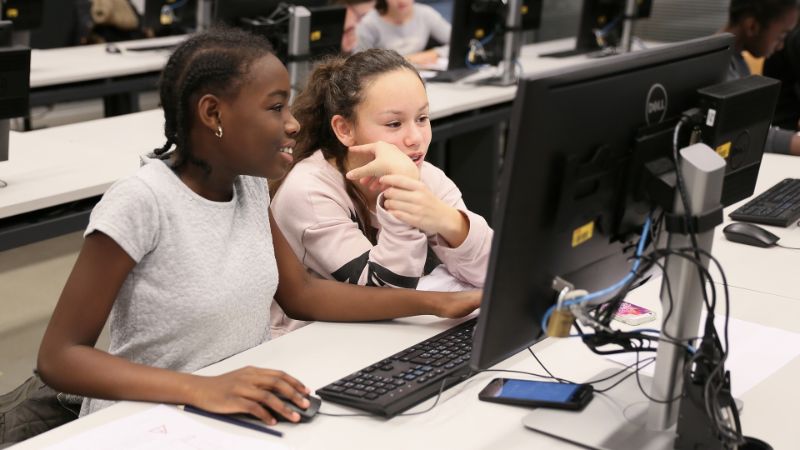More girls in STEM disciplines – But how?
"Put yourself in the shoes of a female high school student," says Ralph Schumacher from the MINT-Learning Centre at ETH Zurich. "Let's call her Salomé. She is a bright young woman with many options. And she typically has better language skills than her male classmates. Why should Salomé therefore invest her energy in physics of all things, when German, English or history are equally interesting?"
At the two Federal Institutes of Technology, young women make up just a third of the students. Their share is increasing, but slowly. The development of professorships is more dynamic, but at a lower level. And all this despite the fact that everyone, from the Federal Council to the ETH Board to the institutions, would like to have more women. Since 2011, Ralph Schumacher, together with Elsbeth Stern, Professor of Research on Learning and Instruction at ETH Zurich, has been investigating in the Swiss STEM Study, a longitudinal study with over 17,000 participants, how these women can be inspired to take up STEM subjects.
Reaching children at an early stage
"It starts in primary school," he says. "At that stage there are hardly any differences between boys and girls. That makes it all the more important to give children a sense of achievement at this early age. So that little Leonie, for example, knows that she has a talent for mathematical thinking. Not only that, but that it is interesting her." Reaching children at an early age is crucial for the development of interest in a subject, because during puberty boys and girls are confronted with strong gender stereotypes about which subjects they are supposedly good at or not.
As part of the MINT study, pupils therefore receive optimised physics lessons from primary school onwards, for example on the Archimedes' principle, to get them interested in physics topics and build up prior knowledge. For grammar school lessons, Schumacher and his team have developed units on mathematical and scientific topics, such as mechanics. "The idea is to first build up a sound understanding of basic concepts such as force and mass. Once they really understand these, then it's easier for the young people to comprehend and apply formulae."
So a class specifically for girls? "No," Elsbeth Stern waves it off, "it turns out that not only the girls benefit from these lessons, but the boys as well."
2500 schoolgirls involved in robotics, programming and mathematics
ETH Zurich offers summer schools, visitor days, workshops and much more for interested young people. EPFL does the same. What's more, it runs its own programme for the promotion of girls in STEM fields. This includes extracurricular workshops and camps and is carried out in the French-speaking and bilingual cantons of Switzerland, as well as in the cantons of Basel-Stadt and Schaffhausen. Every year, 2500 schoolgirls are involved in robotics, programming and mathematics.
Pupils are also welcome at the other institutions of the ETH Domain, the PSI, the WSL, the Empa and the Eawag. They regularly conduct guided tours for school classes, organise summer camps and participate in the "Seitenwechsel", the annual Future Day, where children learn about typical professions of the opposite sex. In many cases, the institutions rely on gender-segregated teaching, which is especially appreciated by girls. It reduces what psychology calls the "stereotype threat": The stress that arises when one has to do something under observation that one supposedly cannot do.
Examples and role models
It is equally important who the children and young people meet when they first come into contact with the natural and technical sciences. If only men are present, Leonie or Salomé are much less likely to imagine themselves working in such a company one day – and are also less likely to choose a course of study in the STEM field.
For Patricia Nitzsche from Empa, it all starts with the apprentices. "We train laboratory assistants, computer scientists and design engineers, among others. The apprentices then often show children and young people around the company. That's why we take great care to train as many girls as possible, even though we receive many more applications from boys." A social media campaign will soon be launched to increase the focus on female researchers at Empa.
The Paul Scherrer Institute (PSI) is also consciously showing students that men and women work together, explains Melina Spycher from the PSI Diversity & Inclusion Unit. "To make female researchers more visible, we ran a poster campaign at the larger Aargau railway stations in 2020. On the posters, female PSI scientists, technicians and engineers explain why they have chosen to do research in the natural and technical sciences."
The same idea has been implemented digitally by the Swiss Federal Institute for Forest, Snow and Landscape Research (WSL). "We have produced YouTube videos in which female researchers explain what they love about their work," says Urte Reckowsky, Coordinator for Diversity and Inclusion at WSL. "We also run a website geared towards children – WSL Junior – which is very gender-appropriate, including the imagery."
The meaning of work
The world is open to women like Salomé. "They are not only looking for exciting work, but also meaningful work," explains Elsbeth Stern. That, for example, is one of the reasons why, in medical studies, women are now in the majority. "In biology or environmental sciences, too, we have to be careful not to lose male students."
Whether it's drilling ice cores on a glacier, building bridges out of wood or programming an app on a computer: there are many opportunities for girls and boys to get in touch with natural and technical sciences today. And the researchers are very enthusiastic about promoting young talent. Of course, the results of their efforts will only be known in a few years’ time. When Salomé and Leonie have – hopefully – decided to take up study, do a Master's degree or write a dissertation in a STEM subject.
